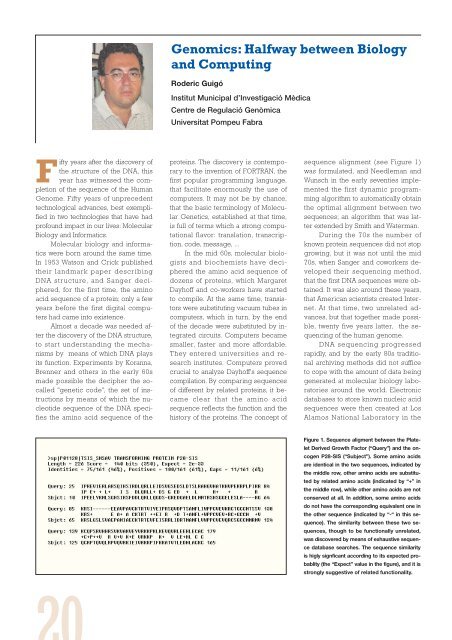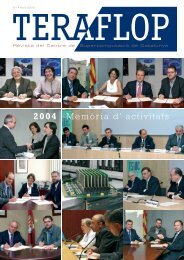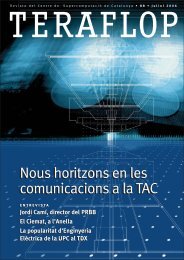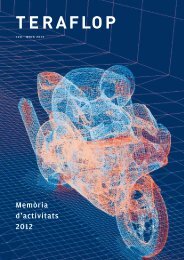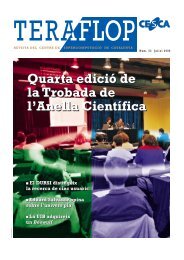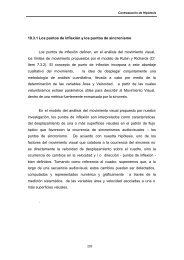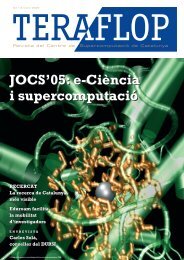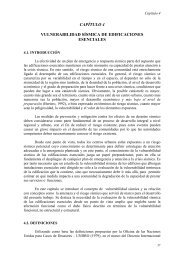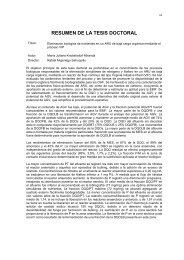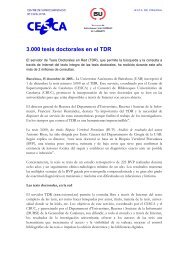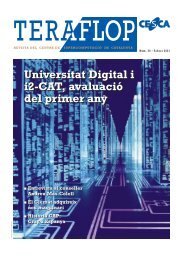Teraflop 73 - Novembre - cesca
Teraflop 73 - Novembre - cesca
Teraflop 73 - Novembre - cesca
Create successful ePaper yourself
Turn your PDF publications into a flip-book with our unique Google optimized e-Paper software.
Fifty years after the discovery of<br />
the structure of the DNA, this<br />
year has witnessed the completion<br />
of the sequence of the Human<br />
Genome. Fifty years of unprecedent<br />
technological advances, best exemplified<br />
in two technologies that have had<br />
profound impact in our lives: Molecular<br />
Biology and Informatics.<br />
Molecular biology and informatics<br />
were born around the same time.<br />
In 1953 Watson and Crick published<br />
their landmark paper describing<br />
DNA structure, and Sanger deciphered,<br />
for the first time, the amino<br />
acid sequence of a protein; only a few<br />
years before the first digital computers<br />
had came into existence.<br />
Almost a decade was needed after<br />
the discovery of the DNA structure,<br />
to start understanding the mechanisms<br />
by means of which DNA plays<br />
its function. Experiments by Koranna,<br />
Brenner and others in the early 60s<br />
made possible the decipher the socalled<br />
"genetic code", the set of instructions<br />
by means of which the nucleotide<br />
sequence of the DNA specifies<br />
the amino acid sequence of the<br />
Genomics: Halfway between Biology<br />
and Computing<br />
Roderic Guigó<br />
Institut Municipal d’Investigació Mèdica<br />
Centre de Regulació Genòmica<br />
Universitat Pompeu Fabra<br />
proteins. The discovery is contemporary<br />
to the invention of FORTRAN, the<br />
first popular programming language,<br />
that facilitate enormously the use of<br />
computers. It may not be by chance,<br />
that the basic terminology of Molecular<br />
Genetics, established at that time,<br />
is full of terms which a strong computational<br />
flavor: translation, transcription,<br />
code, message, ...<br />
In the mid 60s, molecular biologists<br />
and biochemists have deciphered<br />
the amino acid sequence of<br />
dozens of proteins, which Margaret<br />
Dayhoff and co-workers have started<br />
to compile. At the same time, transistors<br />
were substituting vacuum tubes in<br />
computers, which in turn, by the end<br />
of the decade were substituted by integrated<br />
circuits. Computers became<br />
smaller, faster and more affordable.<br />
They entered universities and research<br />
institutes. Computers proved<br />
crucial to analyze Dayhoff's sequence<br />
compilation. By comparing sequences<br />
of different by related proteins, it became<br />
clear that the amino acid<br />
sequence reflects the function and the<br />
history of the proteins. The concept of<br />
sequence alignment (see Figure 1)<br />
was formulated, and Needleman and<br />
Wunsch in the early seventies implemented<br />
the first dynamic programming<br />
algorithm to automatically obtain<br />
the optimal alignment between two<br />
sequences; an algorithm that was latter<br />
extended by Smith and Waterman.<br />
During the 70s the number of<br />
known protein sequences did not stop<br />
growing, but it was not until the mid<br />
70s, when Sanger and coworkers developed<br />
their sequencing method,<br />
that the first DNA sequences were obtained.<br />
It was also around these years,<br />
that American scientists created Internet.<br />
At that time, two unrelated advances,<br />
but that together made possible,<br />
twenty five years latter, the sequencing<br />
of the human genome.<br />
DNA sequencing progressed<br />
rapidly, and by the early 80s traditional<br />
archiving methods did not suffice<br />
to cope with the amount of data being<br />
generated at molecular biology laboratories<br />
around the world. Electronic<br />
databases to store known nucleic acid<br />
sequences were then created at Los<br />
Alamos National Laboratory in the<br />
Figure 1. Sequence aligment between the Platelet<br />
Derived Growth Factor (“Query”) and the oncogen<br />
P28-SIS (“Subject”). Some amino acids<br />
are identical in the two sequences, indicated by<br />
the middle row, other amino acids are substituted<br />
by related amino acids (indicated by “+” in<br />
the middle row), while other amino acids are not<br />
conserved at all. In addition, some amino acids<br />
do not have the corresponding equivalent one in<br />
the other sequence (indicated by “-“ in this sequence).<br />
The similarity between these two sequences,<br />
though to be functionally unrelated,<br />
was discovered by means of exhaustive sequence<br />
database searches. The sequence similarity<br />
is higly signficant according to its expected probablity<br />
(the “Expect” value in the figure), and it is<br />
strongly suggestive of related functionality.


